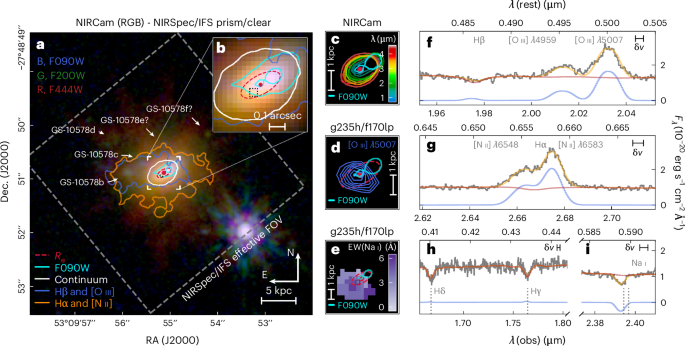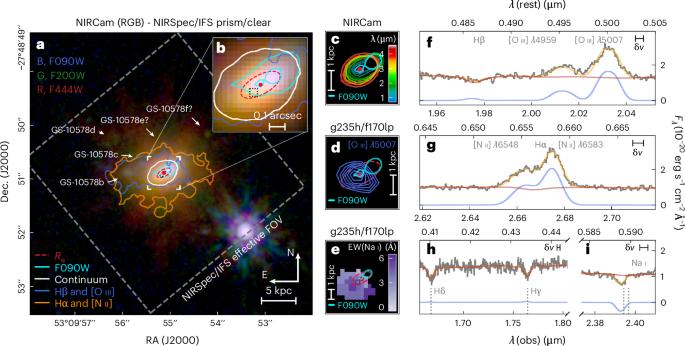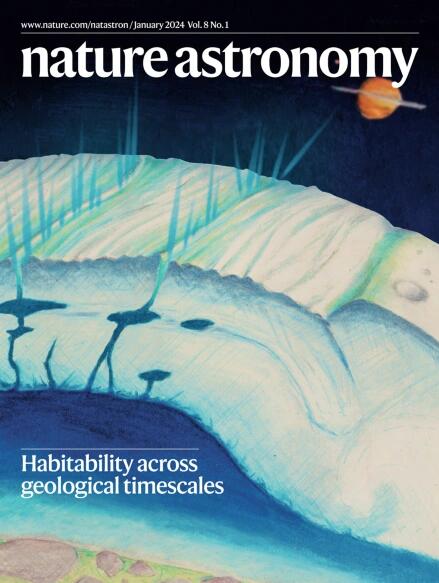A fast-rotator post-starburst galaxy quenched by supermassive black-hole feedback at z = 3
IF 12.9
1区 物理与天体物理
Q1 ASTRONOMY & ASTROPHYSICS
引用次数: 0
Abstract
The most massive galaxies in the Universe stopped forming stars due to the time-integrated feedback from central supermassive black holes (SMBHs). However, the exact quenching mechanism is not yet understood, because local massive galaxies were quenched billions of years ago. Here we present JWST/NIRSpec integral-field spectroscopy observations of GS-10578, a massive, quiescent galaxy at redshift z = 3.064 ± 0.002. From its spectrum, we measure a stellar mass M⋆ = 1.6 ± 0.2 × 1011 M⊙ and a dynamical mass Mdyn = 2.0 ± 0.5 × 1011 M⊙. Half of its stellar mass formed at z = 3.7–4.6, and the system is now quiescent, with a current star-formation rate of less than 19 M⊙ yr−1. We detect ionized- and neutral-gas outflows traced by [O iii] emission and Na i absorption, with mass outflow rates 0.14–2.9 and 30–100 M⊙ yr−1, respectively. Outflow velocities reach vout ≈ 1,000 km s−1, comparable to the galaxy escape velocity. GS-10578 hosts an active galactic nucleus, evidence that these outflows are due to SMBH feedback. The neutral outflow rate is higher than the star-formation rate. Hence, this is direct evidence for ejective SMBH feedback, with a mass loading capable of interrupting star formation by rapidly removing its fuel. Stellar kinematics show ordered rotation, with spin parameter $${\lambda }_{{{{R}}}_{{\rm{e}}}}=0.62\pm 0.07$$ , meaning GS-10578 is rotation-supported. This study presents direct evidence for ejective active galactic nucleus feedback in a massive, recently quenched galaxy, thus helping to clarify how SMBHs quench their hosts. The high value of $${\lambda }_{{{{R}}}_{{\rm{e}}}}$$ implies that quenching can occur without destroying the stellar disk. A massive galaxy hosting an accreting supermassive black hole two billion years after the Big Bang shows fast neutral-gas outflows that are capable of stopping star formation by removing its fuel while the stars keep rotating in a disk.


z=3时被超大质量黑洞反馈淬灭的快速旋转后恒星爆发星系
由于中心超大质量黑洞(SMBH)的时间积分反馈,宇宙中质量最大的星系停止了恒星的形成。然而,由于本地大质量星系早在数十亿年前就已熄灭,因此确切的熄灭机制尚不清楚。在这里,我们展示了JWST/NIRSpec对GS-10578的积分场光谱观测,这是一个红移z = 3.064 ± 0.002的大质量静止星系。从它的光谱中,我们测得恒星质量 M⋆ = 1.6 ± 0.2 × 1011 M⊙,动力质量 Mdyn = 2.0 ± 0.5 × 1011 M⊙。其恒星质量的一半形成于 z = 3.7-4.6,该系统目前处于静态,恒星形成速率小于 19 M⊙ yr-1。我们通过[O iii]发射和Na i吸收探测到了电离气体和中性气体外流,质量外流率分别为0.14-2.9和30-100 M⊙ yr-1。外流速度达到 vout ≈ 1,000 km s-1,与星系逃逸速度相当。GS-10578上有一个活动星系核,证明这些外流是由SMBH反馈引起的。中性外流速率高于恒星形成速率。因此,这是喷出式 SMBH 反馈的直接证据,其质量负荷能够通过快速清除其燃料来中断恒星的形成。恒星运动学显示了有序的自转,自旋参数为({\lambda }_{{{{R}}}_{{\rm{e}}}}=0.62\pm 0.07),这意味着GS-10578是自转支持的。这项研究提供了一个大质量、最近淬火的星系中喷射活动星系核反馈的直接证据,从而有助于澄清SMBH如何淬火它们的宿主。高值的\({\lambda }_{{{{R}}}_{\rm{e}}}}\) 意味着淬火可以在不破坏恒星盘的情况下发生。
本文章由计算机程序翻译,如有差异,请以英文原文为准。
求助全文
约1分钟内获得全文
求助全文
来源期刊

Nature Astronomy
Physics and Astronomy-Astronomy and Astrophysics
CiteScore
19.50
自引率
2.80%
发文量
252
期刊介绍:
Nature Astronomy, the oldest science, has played a significant role in the history of Nature. Throughout the years, pioneering discoveries such as the first quasar, exoplanet, and understanding of spiral nebulae have been reported in the journal. With the introduction of Nature Astronomy, the field now receives expanded coverage, welcoming research in astronomy, astrophysics, and planetary science. The primary objective is to encourage closer collaboration among researchers in these related areas.
Similar to other journals under the Nature brand, Nature Astronomy boasts a devoted team of professional editors, ensuring fairness and rigorous peer-review processes. The journal maintains high standards in copy-editing and production, ensuring timely publication and editorial independence.
In addition to original research, Nature Astronomy publishes a wide range of content, including Comments, Reviews, News and Views, Features, and Correspondence. This diverse collection covers various disciplines within astronomy and includes contributions from a diverse range of voices.
 求助内容:
求助内容: 应助结果提醒方式:
应助结果提醒方式:


